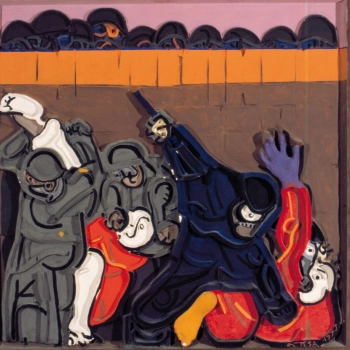Il Progetto
Il progetto della Casa di Ortega, realizzato dalla Fondazione Zètema di Matera, è stato ideato con il duplice intento di documentare la presenza a Matera del grande artista spoagnolo Josè Ortega e di favorire la riscoperta e la valorizzazione della tradizione artigiana locale.
Le aree espositive ospitano le opere realizzate da Ortega negli anni 70, durante il suo soggiorno a Matera, e da lui affidate agli amici del Circolo La Scaletta. Si tratta di venti bassorilievi policromi che compongono le due serie narrative Pasaron e “Muerte y Nacimiento”. Ortega eseguì questi pannelli in collaborazione con i maestri artigiani materani utilizzando in modo innovativo l'antichissima tecnica della cartapesta e sono proprio queste produzioni pittoriche a costituire il filo conduttore del progetto che vuole mettere in evidenza l'importanza del legame tra arte nobile e antichi mestieri. Per rimarcare tale fecondo rapporto gli ambienti, suddivisi secondo un'ideale destinazione d'uso domestica (sala da pranzo, camera da letto, soggiorno, cucina), sono impreziositi da arredi e decorazioni realizzati da artigiani locali. Tali pregevoli manufatti incorniciano le opere del maestro spagnolo, creando, così, un dialogo che si impone agli occhi del visitatore per l'armonica naturalezza con cui le parti interagiscono. In questa prospettiva svolgono un ruolo di primo piano le produzioni ceramoplastiche dell'artigiano materano Giuseppe Mitarotonda che è stato uno stretto collaboratore di Josè Ortega.
Il Palazzo
La Casa di Ortega è situata nel Sasso Barisano in via San Nicola del Sole, asse viario che segue il perimetro delle antiche mura della città.
Il palazzo, risalente al XVII secolo, fu costruito su un antico fortilizio longobardo in una posizione dominante e di grande suggestione ambientale. Nel tardo Seicento l'intero edificio ha subìto un'opera di rimodulazione, con l'ampliamento degli ambienti posti ad est e la costruzione del portale d'ingresso e della balconata impreziosita da colonnine lavorate. L'immobile, a seguito delle leggi di risanamento dei Sassi, fu svuotato dei suoi originari abitanti ed è stato per oltre trent'anni disabitato e non utilizzato. Negli anni 70 venne in parte acquistato dall'artista spagnolo Josè Ortega e, dopo la sua morte, i suoi eredi hanno autorizzato la donazione del palazzo alla Fondazione Zétema con il vincolo di destinazione museale. Ora grazie al progetto di recupero è stato restituito ad una qualificata funzione culturale e salvato dal degrado e dall'abbandono.
Le Opere di Josè Ortega
Per realizzare i cicli "Pasaron" e "Muerte y Nacimiento" Ortega sperimenta la possibilità di dare "tridimensionalità" alla sua pittura attraverso l'uso della cartapesta. Insieme ai maestri cartapestai materani l'artista crea bassorilievi in terracotta da cui realizza calchi in gesso nei quali viene plasmato l'impasto cartaceo. Le opere così modellate sono fissate su un’impalcatura di legno e, infine, dipinte. I colori sono fondamentali protagonisti dell’arte di Ortega, colori vivi, resi con pennellate nette, che conferiscono a un materiale tradizionale, povero e riciclabile, un’aura di sacralità. Le scelte cromatiche assumono un fondamentale valore semantico: il bianco e il giallo, colori della vita e della fioritura primaverile; il rosso della passione e della tragedia, della bandiera e del sangue; il nero delle forze della morte e delle divise militari; il viola del martirio; il blu del pugno e della rivolta. L’artista traduce in uno stile unico e inconfondibile gli insegnamenti di altri illustri predecessori: le atmosfere cupe di El Greco, alcuni temi di Goya, le deformazioni anatomiche di Picasso, le masse di colore e le linee di Mirò. I bassorilievi raccontano i conflitti, il male e la dittatura che, in ogni Paese e in ogni epoca, schiacciano l’uomo, il cui riscatto avviene grazie alla passione e alla lotta, in una successione ininterrotta di cicli di morte e nascita.









































